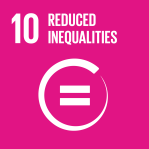To reduce these inequalities, the 2030 Agenda aims to progressively achieve and sustain income growth of the poorest population at a rate higher than the national average. An important aspect envisaged in this sense is to empower and promote the social, economic and political inclusion of all, irrespective of age, sex, disability, race, ethnicity, origin, religion or economic or other status. At the same time, the Agenda is focusing on an orderly and well-informed migration process.
|
| Results of indicators nationalization SDG 10
|
| Goal 10. Reduce inequality within and among countries |
|
| Goal 10. Reduce inequality within and among countries | |
| GLOBAL TARGETS 2019 | GLOBAL INDICATORS 2019 |
| NATIONAL TARGETS 2017* | NATIONAL INDICATORS 2017* |
| 10.1 By 2030, progressively achieve and sustain income growth of the bottom 40 per cent of the population at a rate higher than the national average | 10.1.1 Growth rates of household expenditure or income per capita among the bottom 40 per cent of the population and the total population |
| 10.1 By 2030, progressively achieve and sustain income growth of the bottom 40 per cent of the population at a rate higher than the national average | 10.1.1 Expenditures growth rates per capita among the bottom 40 per cent of the population and the total population |
| 10.2 By 2030, empower and promote the social, economic and political inclusion of all, irrespective of age, sex, disability, race, ethnicity, origin, religion or economic or other status | 10.2.1 Proportion of people living below 50 per cent of median income, by sex, age and persons with disabilities |
| 10.2. By 2030, empower and promote the social, economic and political inclusion of all, irrespective of age, sex, disability, race, ethnicity, origin, religion or economic or other status | 10.2.1 Relative poverty rate, by sex, age, persons with disability, % |
| 10.3 Ensure equal opportunity and reduce inequalities of outcome, including by eliminating discriminatory laws, policies and practices and promoting appropriate legislation, policies and action in this regard | 10.3.1 Proportion of population reporting having personally felt discriminated against or harassed in the previous 12 months on the basis of a ground of discrimination prohibited under international human rights law |
| 10.3 Ensure equal opportunity and reduce inequalities of outcome, including by eliminating discriminatory laws, policies and practices and promoting appropriate legislation, policies and action in this regard | 10.3.1 Proportion of population reporting having been discriminated against or harassed in the previous 12 months, by sex |
|
|
|
| | 10.3.2 Discrimination or harassment cases reported per 10 000 population, by sex |
| 10.4 Adopt policies, especially fiscal, wage and social protection policies, and progressively achieve greater equality | 10.4.1 Labour share of GDP, comprising wages and social protection transfers |
| 10.4 Adopt policies, especially fiscal, wage and social protection policies, and progressively achieve greater equality | 10.4.1 Proportion of labour force costs reported to the Gross Value Added, % |
| 10.5 Improve the regulation and monitoring of global financial markets and institutions and strengthen the implementation of such regulations | 10.5.1 Financial Soundness Indicators |
| Not relevant | |
| 10.6 Ensure enhanced representation and voice for developing countries in decision-making in global international economic and financial institutions in order to deliver more effective, credible, accountable and legitimate institutions | 10.6.1 Proportion of members and voting rights of developing countries in international organizations |
| Not relevant | |
| 10.7 Facilitate orderly, safe, regular and responsible migration and mobility of people, including through the implementation of planned and well-managed migration policies | 10.7.1 Recruitment cost borne by employee as a proportion of yearly income earned in country of destination |
| 10.7 Ensure a legal, equitable, well-informed hiring process of migrants | 10.7.1 Recruitment cost borne by employee as a proportion of yearly income earned in country of destination |
|
| 10.7.2 Number of countries that have implemented well-managed migration policies |
| | 10.7.2.1 Number of bilateral agreements on employment abroad |
|
|
|
| | 10.7.2.2 Number of bilateral agreements on social security |
| 10.a Implement the principle of special and differential treatment for developing countries, in particular least developed countries, in accordance with World Trade Organization agreements | 10.a.1 Proportion of tariff lines applied to imports from least developed countries and developing countries with zero-tariff |
| Not examined | |
| 10.b Encourage official development assistance and financial flows, including foreign direct investment, to States where the need is greatest, in particular least developed countries, African countries, small island developing States and landlocked developing countries, in accordance with their national plans and programmes | 10.b.1 Total resource flows for development, by recipient and donor countries and type of flow (e.g. official development assistance, foreign direct investment and other flows) |
| Not examined | |
| 10.c By 2030, reduce to less than 3 per cent the transaction costs of migrant remittances and eliminate remittance corridors with costs higher than 5 per cent | 10.c.1 Remittance costs as a proportion of the amount remitted |
| Not examined | |
Note:
* Nationalized targets, nationalized indicators and statistical data presented under this heading are taken from the Report "Nationalization of indicators for SDG" and Adapting the 2030 Agenda on Sustainable Development to the context of the Republic of Moldova elaborated by Expert-Grup in collaboration with the Government of the Republic of Moldova and UN Moldova in 2017 and presents the situation at that time. Currently, the next stage of revising the nationalized indicators is taking place, thus, some indicators can be revised or supplemented later.
 |  |  |  |  |  |  |  |  |
 |  |  |  |  |  |  |  |  |


 Goal 10: Reduce inequality within and among countries
Goal 10: Reduce inequality within and among countries 
 Green line: 022 40 30 00
Green line: 022 40 30 00